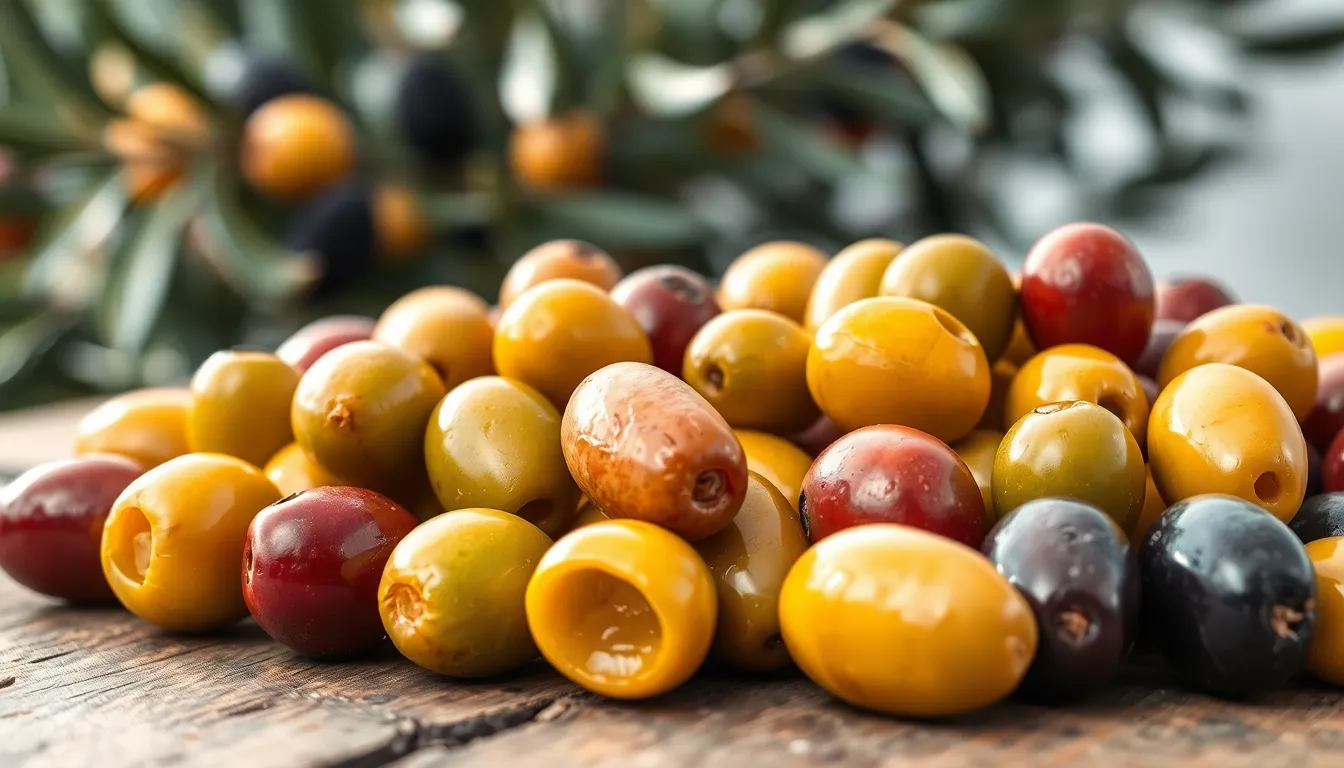Imagine drizzling fresh, homemade olive oil over your salad or dipping warm bread into a fragrant bowl of liquid gold. Sounds dreamy, right? Making olive oil at home might seem like a task reserved for Italian nonnas, but it’s easier than you think. With just a few simple steps and some elbow grease, you can impress your friends and elevate your culinary game.
Table of Contents
ToggleUnderstanding Olive Oil
Understanding olive oil involves recognizing its types and health benefits. This knowledge enhances the olive oil making experience and the enjoyment of its use in culinary dishes.
Types of Olive Oil
Different types of olive oil exist depending on production methods and quality. Extra virgin olive oil features the highest quality and lowest acidity, achieved through first cold-pressing. Virgin olive oil also undergoes cold-pressing but has slightly higher acidity. Refined olive oil involves processing to remove defects, resulting in a lighter flavor. Pure olive oil combines virgin and refined oils, offering a milder taste. Each variety serves different culinary purposes, ensuring options for diverse cooking styles.
Health Benefits of Olive Oil
Numerous health benefits accompany olive oil consumption. Rich in monounsaturated fats, it promotes heart health and lowers bad cholesterol levels. Antioxidants present in olive oil combat oxidative stress, potentially reducing inflammation. Studies associate regular olive oil intake with lower risks of chronic diseases, including type 2 diabetes and certain cancers. The Mediterranean diet, known for its heart-healthy qualities, prominently features olive oil as a staple ingredient. Using olive oil regularly supports overall well-being and enhances flavor in meals.
Selecting the Right Olives

Selecting the right olives is crucial for producing high-quality olive oil. Optimal choices lead to better flavor and health benefits.
Choosing Olive Varieties
Different varieties yield distinct flavors and aromas. Popular olive types include Arbequina, known for its fruity notes, and Kalamata, featuring a robust taste. When selecting, consider the intended use of the oil. Table olives may work, but specialty olives often provide superior flavor profiles. Ensure the chosen variety fits personal preferences and culinary needs.
Ripeness and Quality Factors
Ripeness plays a pivotal role in oil quality. Harvest olives at the right time for optimal oil extraction. Unripe olives tend to have higher bitterness, while overripe ones can result in poor flavor. Quality indicators include firm texture and vibrant color. Inspect for blemishes or spoilage; fresh olives yield the best oil. Ultimately, using high-quality, ripe olives enhances the final product while promoting a rich taste and aroma.
Equipment Needed
Making olive oil at home requires specific equipment to streamline the process. The quality of the tools directly influences the final product, ensuring a successful extraction.
Essential Tools for Extraction
A fruit crusher or a hammer mill breaks down olives into a paste. This step allows for better oil extraction. A traditional press or hydraulic press extracts oil from the paste. These presses apply pressure effectively to separate oil from the solids. Additionally, an oil separator plays a crucial role by clarifying the oil, separating it from water and residue. Having a thermometer measures the temperature during the extraction process to prevent overheating, which can affect flavor.
Optional Equipment for Efficiency
A stone mill enhances flavor extraction through gentle crushing without excessive heat. A food processor provides an alternative for creating olive paste if a fruit crusher isn’t available. Using a fine mesh strainer can improve clarity, filtering out remaining solids. A bottling funnel simplifies transferring the oil into storage containers without spills. Sanitation is key, so sterilizing jars and bottles ensures the oil remains pure and free of contaminants. Select tools based on availability and desired efficiency for optimal results.
The Process of Making Olive Oil
The process of making olive oil involves several key steps. Each phase contributes to producing high-quality oil.
Harvesting Olives
Timing matters during the harvesting of olives. Picking olives at their peak ripeness significantly enhances flavor. Handpicking ensures minimal damage, preserving the fruit’s integrity. Varieties such as Arbequina or Kalamata exhibit different flavors, affecting the oil’s characteristics. Timing the harvest between late summer and early fall optimizes quality.
Cleaning and Preparing Olives
Cleaning olives removes impurities that may affect oil quality. Rinse olives under running water to eliminate dirt and debris. Sorting olives by ripeness ensures uniformity in flavor and extraction. Discard any damaged fruit to prevent off-flavors. After cleaning, drying the olives with a clean cloth eliminates excess moisture, preparing them for crushing.
Crushing and Grinding
Crushing olives starts releasing their natural oils. Use a fruit crusher or hammer mill for this process. Reduce olives to a paste, ensuring that both the flesh and pits are incorporated. Different ground textures may influence flavor extraction. The goal is to achieve a consistent paste that allows for optimal oil separation during pressing.
Pressing the Olive Paste
Pressing is crucial for extracting oil from the olive paste. A traditional press or hydraulic press applies pressure to release oil. The process may vary based on the method used, but the objective remains the same. Achieving maximum oil yield involves applying sufficient pressure without overheating, which can affect flavor. Collect the liquid output consisting of oil and water.
Separating Oil from Water
Oil separation is the final phase in the olive oil making process. After pressing, the mixture of oil and water requires clarification. Allow the liquid to sit, as oil naturally rises to the top. Skim the oil from the surface for purity. Utilizing an oil separator may expedite this process, ensuring clearer oil that enhances the final product’s quality.
Storing Your Olive Oil
Storing olive oil properly ensures it retains flavor and quality. Appropriate conditions extend its lifespan and maintain its health benefits.
Best Storage Practices
Store olive oil in a dark, cool place. Light and heat degrade the oil’s quality over time. Use dark glass containers or metal tins to protect against light exposure. Avoid plastic bottles as they allow light to penetrate. Seal containers tightly to minimize contact with air, which leads to oxidation. Regularly check oil for rancidity, looking for off odors or unusual flavors.
Shelf Life and Quality Maintenance
Olive oil typically lasts 18 to 24 months when stored correctly. Freshness greatly influences flavor and health properties. Monitor the harvest date on labels to ensure optimal use. Opened bottles should be consumed within a few months for peak quality. Freezing oil isn’t recommended, as it alters texture. Keep olive oil away from appliances that emit heat, like stoves and ovens, to preserve integrity.
Making olive oil at home is a rewarding experience that brings a personal touch to culinary creations. With the right olives and equipment anyone can produce high-quality oil that enhances flavors and promotes health.
Proper storage ensures the longevity and freshness of the oil allowing it to maintain its unique taste and health benefits. Embracing this process not only elevates cooking skills but also fosters a deeper connection to the ingredients used in everyday meals.
As one experiments with different olive varieties and techniques the joy of homemade olive oil will surely become a cherished part of their kitchen adventures.




